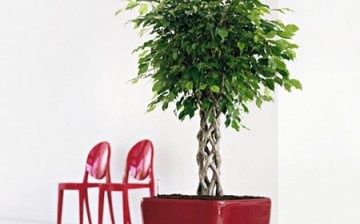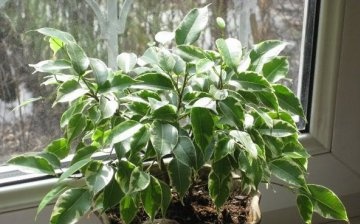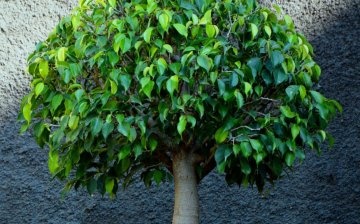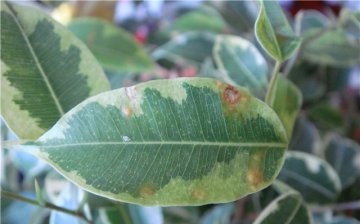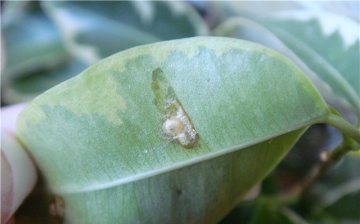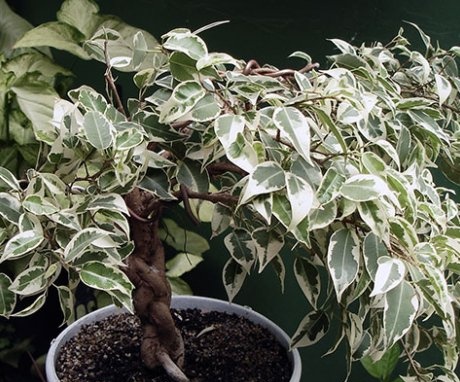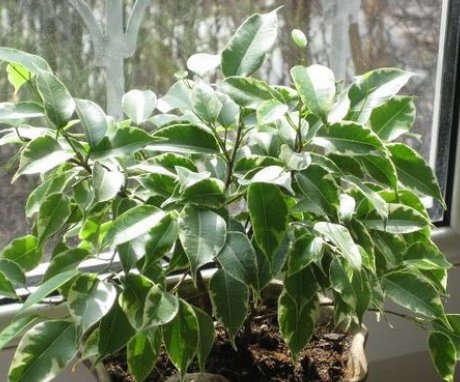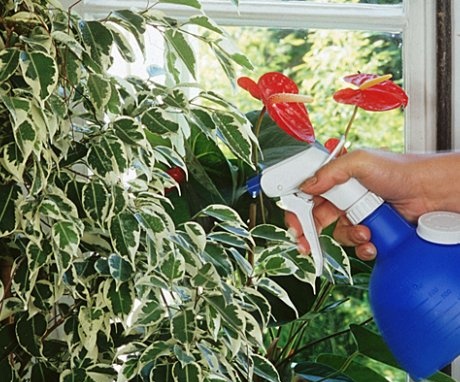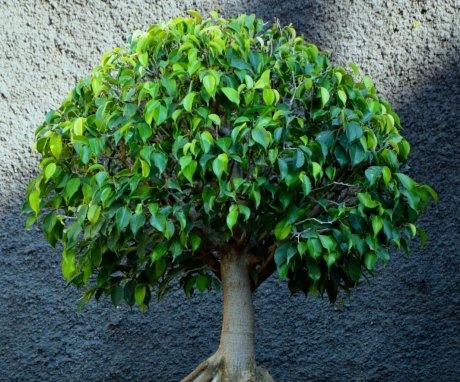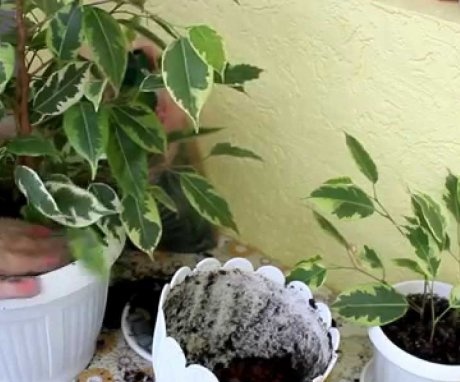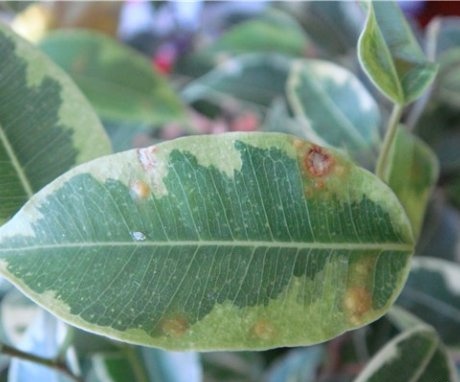Tips for florists: proper care for Benjamin's ficus
Ficus Benjamin grows naturally in South Asia, the Philippines, and Australia. It grows up to 25 m long, looks like a tree or a large bush, and at home its height is only 1.5-2 meters. It has a grayish trunk with small strokes, branches sloping downward, dense glossy leaves on small petioles up to 2.5 cm.
Content:
- Indoor varieties
- Lighting and temperature control
- Watering and feeding
- Pruning
- Transfer
- Ficus diseases: types and causes
Indoor varieties
There are many plant varieties:
- Variety "Monique" - has thin twigs and light leaves slightly wavy along the edge.
- "De Dumbbell" - differs in white leaves, on which there are a few blotches of green.
- "Nicole" - has elongated leaves with light edges.
- "Eldorado" - is distinguished by spotting and tricolor color, the leaves are brown, white and green.
- "Baroque" - it is very difficult to grow it. This is a tiny plant with leaves twisted into a spiral.
That is, there are very unusual decorative varieties, like "Daniel" with almost white leaves or "Eldorado" with tricolor leaves.
Lighting and temperature control
To put ficus recommended in a bright place, for example, on a windowsill on the east, south-east, west side of the room. The place is chosen so that later it does not need to be rearranged. In the summer, take it out to the balcony. The tree does not like direct sunlight, so you need to protect it from the sun.
In winter, he needs additional lighting, you can apply phytolamps... Variegated varieties need more intense lighting, since with a lack of it, the foliage loses its decorative effect, turns green.
The plant does not like direct sunlight, but the lighting itself loves, because of this, it is best placed on the east window.
Ficus does not tolerate temperatures below 15 ° C, as well as temperature changes. The most comfortable air temperature for him is from 18 to 30 ° C. If the air in the room is too dry, then it is needed often. spray and rinse every month with warm boiled water. The tree is native to the subtropics and therefore likes warm, humid air.
Watering and feeding
Feel the soil to determine if you need to water. If the top layer of the soil is 3-4 cm dry, then you need to pour it over with settled warm water. The tree does not tolerate excess moisture. Therefore, the water that will be in the pan must be drained so that the roots do not rot. Excess moisture remaining in the pallet must be drained to prevent the possibility of root rot.
Since in the wild, ficus grows in hot countries, it is easier to tolerate drought than waterlogging of the soil.
Top dressing of ficus:
- Fertilizers are applied alternating mineral and organic feeding.
- When the ficus is actively growing, add nitrogen to the soil.
- Pour urea into water and water the plant.
- In March-April, feed once a month, and in May - once every 3 weeks.
- In summer - once every 2 weeks.
- In winter, the ficus is not fed, since it is at rest.
At first, when planting a flower, it does not need a year. fertilizers, since the soil is sufficiently nutritious, after fertilization, it must be applied depending on the season.
Pruning
When the ficus grows to the required height, carefully cut off the top, this will cause new side shoots to grow, they can also be cut off sometimes. Prune the plant in winter, remove strongly elongated shoots. To maintain shape, this must be done in 2-3 years.
Also prune dry stems and weak shoots from the plant. Those cuttingsthat you cut in the spring and summer use for breeding, place them in water for rooting. When pruning, ficus produces milky juice, it is wiped with a damp cloth, and the slices must be sprinkled with chopped coal.
You can independently form the crown and trunk - weave a pigtail from young trunks.
To do this, it is necessary to select 3 young plants 13-15 cm high, since the trunk of older plants is lignified. To braid a braid, you need to be careful prune several side shoots. Do not leave hemp, as they can cause the plant to develop a disease - a fungus.
Young plants need to be tied together, slightly above the roots and begin to weave a braid:
- When weaving, it is necessary that there is a little space between the stems, since the trunks of the plants will grow.
- Use soft threads to secure the braid. Then the threads will not injure the stems.
- Under the crown, the braid is also fixed with soft threads.
- Then plant the intertwined ficuses in a pot that has drainage and fertile soil.
Usually the ficus is cut off after 2-3 years.
Transfer
When the plant is transplanted:
- After buying a flower in a store.
- If the ground dries up very quickly after glazeand intertwined roots are visible on the sides of the pot.
- During breeding.
- If the soil is affected by a fungus or some other disease.
- A young tree needs to be replanted annually. If the plant has reached 4 years old, then it can be transplanted every 2-3 years.
The best thing transplant plant in spring and summer. After abundant watering, remove the tree from the pot, shake off the top layer of soil, then transfer it to a new pot, add fertile soil. The new pot should be a few centimeters larger than the previous one. If the ficus is already very old, then transplanting can damage its health, change the topsoil every year.
Ficus diseases: types and causes
Causes of diseases
- Inappropriate lighting. If you see that a flower has yellow leaves, they fall off, then it lacks light. When brown spots appear on the leaves, the ficus is exposed to direct sunlight. It is best to put the ficus on the east window. Then it will be lit up in the morning.
- Violation of optimal air temperatures. Ficus does not like sudden changes in temperature and drafts.
- Excessive dryness of the air. The leaves of the ficus begin to fall off. The plant does not need to be placed near heating appliances. It is also needed often spray.
- Waterlogging of the soil. Because of this, the earth rots, and spots form on the leaves. Water the plant if the soil is dry, watering carry out with warm water.
It is necessary to observe proper care of the plant, keep it at a temperature of 18-30 degrees, periodically humidify the air.
Types of diseases:
- Powdery mildew... This is a fungus, it looks like a powdery white coating.
- Cercosporosis. The fungus appears as tiny dark dots on the underside of the leaves, after the leaves turn yellow and wither. Sick leaves are cut off, and the ficus itself is sprayed with systemic fungicide or dinocap.
- Anthracnose... These are dark spots on leaves and stems. The diseased areas are cut off, the ficus is sprayed with a fungicide.
- Black fungus. Looks like a sooty dry film. With this disease, the plant is thoroughly wiped with a wet rag.
- Root rot. Occurs due to excess moisture. It is necessary to cut off the decayed roots.Transplant the plant itself into new soil, and then water with carbendazim.
If your plant is suddenly losing its foliage, keep looking after it - spray and water frequently in dry soil. With proper care, a lush crown will appear very quickly in the ficus.
Benjamin Ficus Pest Control
The most common ficus pests:
- Mealybug. These are whitish small insects, they resemble cotton.
- Shield. Small insects are brown in color, look just like bumps, they attach to the trunk and stems. For removing pests first you need to wipe the leaves with a cloth dipped in water. Then sprayed with insecticide. Natural remedy can be used: 50 g garlic rub, pour in 1 liter of boiling water, leave for 6 hours, then strain the tincture. Spray the plant.
- Aphid. It is easy to remove it with a solution of laundry soap by washing the leaves with it. In 1 liter of warm water, rub 10 g of soap. Can be sprayed with broths and infusions: from dandelions, husks Luke, wormwood, peel of lemons.
- Spider mite. He loves dry air, because of this it does not appear if you often spray the plant. On the upper side of the leaves, you may notice yellow spots, after the leaves fall off. They destroy the tick with insecticides.
With proper care of the ficus, you will get not only a beautiful, but also a useful plant, since the phytoncides that are secreted by the leaves make the air cleaner and better.
More information can be found in the video.



